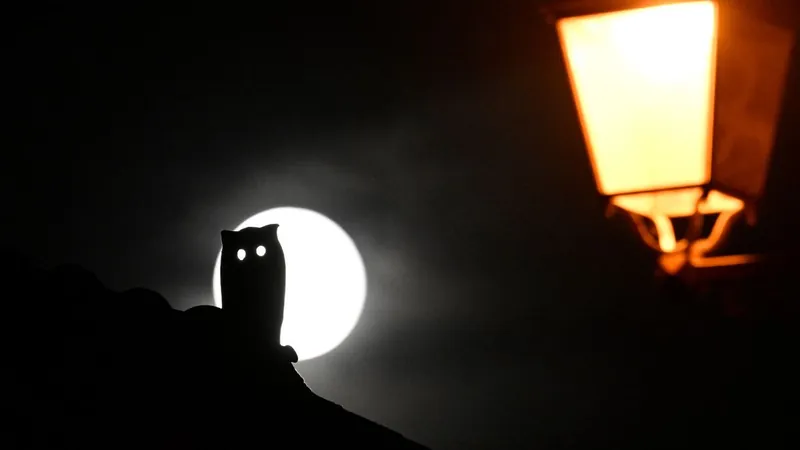
The Hunter's Supermoon: Witness the Spectacular Lunar Event of 2024!
2024-10-15
Author: Ken Lee
Prepare for an astronomical spectacle this week as the largest full moon of 2024 graces our skies!
On Thursday, October 17, at precisely 7:26 a.m. EDT (11:26 GMT), the moon will reach its full phase, illuminating the night with an extraordinary brightness. However, for those keen on witnessing the peak of this celestial event, the best time will be the night prior, on Wednesday, October 16, when the moon will be at perigee—its closest approach to Earth—at 8:48 p.m. EDT (00:48 GMT on October 17). At this point, the moon will be just 221,938 miles (357,174 km) away, resulting in a full moon that is approximately 14% brighter than usual!
This impressive phenomenon, commonly referred to as a "supermoon," encompasses both the full moon phase and its proximity to Earth. Dr. Fred Espenak, a knowledgeable retired NASA astrophysicist, categorizes supermoons as those that occur when the moon is within 90% of its closest approach. 2024 will witness four supermoons spread across August, September, October, and November, but this particular October supermoon will stand out for how closely the full moon coincides with its perigee.
Mark your calendars for April 13, 2025, when a different kind of lunar event will occur—a "micromoon." During this time, the moon will be at its farthest distance from Earth, appearing significantly smaller in the sky.
Traditionally, October's full moon has been named the Hunter's Moon.
This is an homage to the hunting season as animals prepare for winter. The harvest is complete, making it the perfect time to track the game, such as deer and foxes, which are now more visible against the newly fallen leaves. This makes for a picturesque setting that resonates with nature lovers and stargazers alike.
Best Viewing Tips
While television meteorologists may suggest that Thursday night will be the prime time for moon gazing, the moon will have already transitioned to a waning gibbous phase by then. The best experience for lovers of the night sky will occur on Wednesday, when the moon will be not only near its closest point but also closer to its full phase.
It's worth noting that the full moon's appearance lasts only a fleeting moment. Still, the days surrounding the full moon provide a dazzling view for the casual observer. It's nearly impossible for the naked eye to discern the subtle changes in the shadowed portions of the moon, allowing it to appear “full” for an extended period.
High Tides on the Rise
This month's supermoon will also coincide with extraordinary tidal changes. Expect "spring" tides, a term that describes the heightened tidal movements occurring during full and new moons due to the moon and sun aligning in their gravitational pulls. However, be aware that the highest tides will occur several days after the supermoon.
For instance, if you're near Boston Harbor, the peak tide height of 12.0 feet will happen at 12:11 p.m. EDT on Friday, nearly two days after the perigee. This means that coastal areas should remain vigilant, especially if storms arise, as they can exacerbate flooding issues.
Observe the Moon's Grandeur
You'll want to catch the Hunter's Supermoon as it rises or sets, creating an optical illusion that can make it appear significantly larger close to the horizon. This effect adds a layer of enchantment to the already stunning view, making it feel as though the moon is within arm's reach.
To effectively plan your moon-gazing adventure, check the moonrise and moonset times for your location utilizing the U.S. Naval Observatory's resources. For those looking to enhance their viewing experience, consider investing in a telescope or binoculars to truly appreciate the details of our lunar companion.
As you prepare for this extraordinary event, don’t forget to share your stunning moon photos! This Hunter's Supermoon promises to be a memorable sight, worthy of capturing and sharing with fellow skywatchers.

 Brasil (PT)
Brasil (PT)
 Canada (EN)
Canada (EN)
 Chile (ES)
Chile (ES)
 España (ES)
España (ES)
 France (FR)
France (FR)
 Hong Kong (EN)
Hong Kong (EN)
 Italia (IT)
Italia (IT)
 日本 (JA)
日本 (JA)
 Magyarország (HU)
Magyarország (HU)
 Norge (NO)
Norge (NO)
 Polska (PL)
Polska (PL)
 Schweiz (DE)
Schweiz (DE)
 Singapore (EN)
Singapore (EN)
 Sverige (SV)
Sverige (SV)
 Suomi (FI)
Suomi (FI)
 Türkiye (TR)
Türkiye (TR)